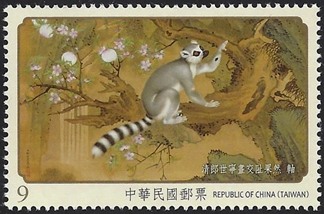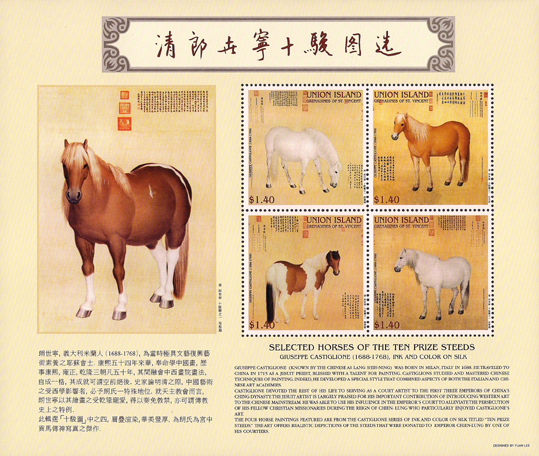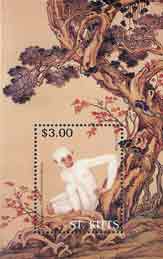The first three images on the above souvenir sheet are (left to right) details from
Castiglione's Inauguration Portrait of Qianlong and Wives (1736),
Castiglione's scroll The Qianlong Emperor Viewing Paintings (1746-c.1750)
by Castiglione and Ding Guanpeng (fl. c. 1738-1768), and The Emperor
Qianlong in His Study (before 1767) attributed to Giuseppe Castiglione
and Jin Tingbiao (active at court 1757-1767).








CHINA (Taiwan) 29 March 2016, an issue of 8 of his paintings: Peach Blossom (5), Peony (5), Peony (7), Begonia and Magnolia (9), Papaver Rhoeas and Iris Japonica (10), Roses and Wild Flowers (10), Cherry Blossoms (12), Carnation (12), Scott 4289-4296


There are also two sets of Castiglione cinderellas, of different sizes, the
origin, reason and date of which are not known to me.
One set (left) is titled Selection of Castiglione's Flower-bird Paintings;
the other (right) is titled at the top Chinese Commemorative Government
Postal Stamp of (National) Treasures,
and at the bottom Castiglione's name in Chinese characters, his dates,
and the subject.

CHINA, 1979, the Summer Palace at Beijing, Scott 1472
While Brother Castiglione is more famous and more represented
in philately as a painter, he was also
an architect. Yuanming Yuan or the Old Summer Palace was laid our during
the Yuan dynasty of the Mongols. But it was fully developed during the
Qing dynasty. Castiglione had been appointed Minister of the Fengchenyuan,
in charge of maintaining the imperial gardens. As such, from 1745 to 1759
he collaborated with his fellow Jesuits, Michel Benoist, Jean-Marie Attiret
and Ignatius Sichelbart, to design
Western-style pavilions, which eventually covered about 4% of the land
area. Western powers, headed by the British and French, destroyed it in
1860. Twenty-six years later it was restored on its original foundations.





CHINA (Taiwan), 2015, the 300th anniversary of Castiglione's arrival
in China
Four stamps and a souvenir sheet featuring his paintings,
issued in coordination with the National Palace Museum's special exhibition
highlighting his life and his art, Scott 4261-4265
The souvenir sheet includes 2 stamps (NT$70 and NT$12) and features Golden
Pheasant in Spring, a hanging scroll, depicting two pheasants perched
on a garden rock beside a mountain stream. Surrounding the rock are flowers,
bamboo and spirit fungi. The stamps show (1) Gathering of Auspicious
Signs, a hanging scroll (NT$5) depicting a celadon vase filled with
plants that signify auspiciousness, including lotus flowers, lotus seed-pods,
and ears of rice, one of Castiglione's earliest dated work. (2) Long-haired
Dog Beneath Blossoms, a hanging scroll (NT$5) with a brown puppy next
to a garden rock beneath a blossoming peach tree. (3) Ayusi Sweeping
Bandits with a Lance, a handscroll (NT$9): Ayusi, a Zunghar from Xinjiang,
after being sentenced to dismemberment for the crime he committed, he
escaped and defected to the Qing court. Upon hearing about his bravery
and his military skills, Emperor Qianlong summoned him, gifting him
with silver and appointing him as an imperial guard. In 1755, Ayusi won
his fame by attacking Gadan-Ola and quelled the rebellion. For this, Emperor
Qianlong wrote an ode and commissioned Castiglione to paint this portrait.
(4) Cochin Lemur, a hanging scroll (NT$9), painted in 1761, this
painting possibly depicts a ring-tailed lemur from Madagascar, but according
to the inscription on the painting, Emperor Qianlong thought it was an
animal called a guoran from Cochin (today's Vietnam).
NEXT




























